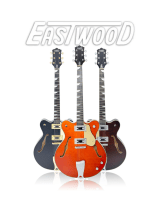
ACTION: The “action” of a guitar refers to the distance between the bottom of your strings and the top
of your frets. After your neck has been set properly, you can further adjust this distance by raising or
lowering the bridge using a slotted screwdriver, or by turning the wheels. Measure the distance
between the bottom of the Low E string and the top of the 12th fret. Set it so that this distance is
~5/64". Measure the distance between the bottom of the High E string and the top of the 12th fret. Set
it so that this distance is ~4/64". From here you can make minor tweaks until the strings are at a height
that is comfortable for your playing.
INTONATION: This refers to the fine-tuning of your guitar. A properly intonated guitar is one that sounds
in tune across the entire neck. This should be your last step of the set-up, as raising your strings or
changing your neck bow can have a drastic effect on your intonation. Using a tuner, make sure all your
strings are in tune first. Check your intonation one string pair at a time beginning with the Low E’s. These
strings should also read as "E" in the 12th fret. If it is flat, you will need to make the strings shorter by
moving the saddle towards the pickups. If the note is sharp, make the strings longer by moving the
saddle away from the pickups. Be sure to re-tune the strings after each adjustment.
PICKUP HEIGHT: This refers to the distance between the bottom of your strings and the top of the pole
pieces in the pickups. These should be set properly so that your strings have equal output, and the
guitar's tone is represented as it should. That said, the following measurements are guidelines only, and










